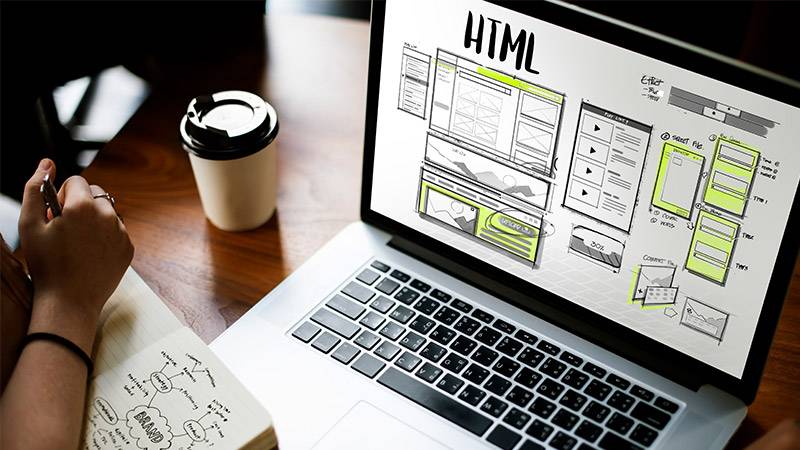Sustainable web design is about reducing the environmental impact of our online presence. It focuses on creating websites that are efficient, use less energy, and are hosted on eco-friendly servers.
This article will guide you through the basics of reducing your digital carbon footprint through thoughtful web design. We’ll cover why it’s important, the principles behind it, and how you can make changes today to create a more sustainable internet.
Let’s get started on making the web a greener place.
Understanding the Digital Carbon Footprint
What is a digital carbon footprint? Simply put, it’s the amount of carbon dioxide (CO2) emissions generated by our online activities. This includes everything from sending an email to streaming a video or hosting a website.
Each online action consumes energy, mainly from data centers, networks, and our devices. These energy sources often rely on fossil fuels, contributing to CO2 emissions. The internet’s vast reach means its environmental impact is significant, yet frequently overlooked.
Web design plays a crucial role in this scenario. A well-designed website can minimize energy consumption. How? By requiring less data to load and run smoothly. This means choosing efficient coding practices, optimizing images, and minimizing the use of resource-heavy elements.
Conversely, a poorly designed website with unoptimized images, excessive use of scripts, and lack of mobile optimization can significantly increase energy usage. Every extra kilobyte requires more power to transmit and display, thus increasing the digital carbon footprint.
The Principles of Sustainable Web Design

Sustainable web design is built on a foundation of key principles aimed at minimizing the environmental impact of websites. By understanding and applying these principles, web designers and developers can contribute significantly to a more sustainable internet.
Efficiency in Design
Efficiency is at the heart of sustainable web design. This means creating websites that are streamlined, load quickly, and consume less energy. It involves adopting a minimalist design approach, where every element serves a purpose, reducing the overall size of web pages and the energy required to load them.
Clean Coding Practices
Clean coding is essential for a sustainable website. Efficient, well-organized code helps reduce the server’s processing load, leading to lower energy consumption. This includes using modern, energy-efficient coding languages, minifying CSS and JavaScript files, and eliminating unnecessary scripts and plugins that add extra weight to your website.
Server Optimization
The choice and optimization of servers play a significant role in sustainable web design. Opting for servers that are energy efficient and powered by renewable energy sources can drastically reduce a website’s carbon footprint. Additionally, using content delivery networks (CDNs) can decrease the distance data travels, further reducing energy use.
Green Hosting
Selecting a green hosting provider is another crucial aspect of sustainable web design. Green hosting companies operate on renewable energy or offset their carbon emissions, making them an environmentally friendly choice for website hosting. This decision not only supports sustainability but also sends a strong message about your commitment to environmental stewardship.
Mobile-First Design and Accessibility
With the increasing use of mobile devices, adopting a mobile-first design approach ensures websites are optimized for energy efficiency on smaller screens. Additionally, making websites accessible to all users, regardless of their abilities, aligns with the inclusive ethos of sustainability, ensuring the web is open and usable for everyone.
Practical Steps to Implement Sustainable Web Design

Adopting sustainable web design practices can significantly reduce a website’s environmental impact. Here are practical steps that designers, developers, and website owners can follow to create more sustainable websites.
Optimizing Images and Media
Images and media files often account for the bulk of a website’s data size, directly impacting its energy consumption.
To reduce this, start by compressing images without sacrificing quality. Tools like TinyPNG or ImageOptim can drastically lower file sizes.
Consider also the format of your images. Formats like WebP offer superior compression and quality characteristics compared to traditional formats like JPEG or PNG.
Implementing lazy loading for images and videos ensures that these resources are only loaded when they’re actually needed, further reducing unnecessary data transfer and energy use.
Mobile-First Design and Accessibility
A mobile-first design approach prioritizes efficiency and performance for mobile users, inherently reducing energy consumption.
Mobile devices, being less power-intensive than desktops, benefit from optimized content that loads quickly and uses less data.
Accessibility practices, such as semantic HTML and efficient navigation, not only make your website more inclusive but also more sustainable.
Screen readers and other assistive technologies benefit from clean, well-structured code that is inherently more energy-efficient.
Use Green Hosting
Choosing a green hosting provider is a direct and impactful step towards sustainable web design.
These providers ensure that the energy used to power servers comes from renewable sources, such as solar or wind. Alternatively, they invest in carbon offsetting projects to balance out their emissions.
This choice significantly lowers the carbon footprint of your website. Since hosting services are essential for any website, opting for an eco-friendly option makes a substantial difference in your site’s environmental impact.
It’s an easy yet effective way to contribute to sustainability in the digital realm, aligning your online presence with broader environmental goals.
Minimize HTTP Requests
Minimizing HTTP requests is crucial for creating a more sustainable website. Each file request—whether for CSS, JavaScript, or images—increases the site’s load time and, consequently, its energy consumption.
By combining files where possible, such as merging multiple CSS or JavaScript files into one, you reduce the number of requests a server needs to process.
Utilizing CSS sprites for images can also decrease requests by combining multiple images into one large file, which is particularly effective for icons and buttons.
Streamlining your site’s structure to eliminate unnecessary files further reduces energy use, making your website more efficient and eco-friendly.
Enable Caching
Enabling caching is a smart strategy for sustainable web design. It allows users to store parts of your site on their local devices after their first visit.
This means that on subsequent visits, their browser can load parts of your site from the cache rather than requesting all the data from the server again.
This significantly reduces the energy required to send and receive data over the network.
Caching not only speeds up the loading time for your website, making for a better user experience, but also decreases the overall energy consumption associated with accessing your site.
Opt for Energy-Efficient Background Processes
Opting for energy-efficient background processes is vital for a sustainable website.
If your site relies on background processes, like database queries or server-side scripts, it’s important to optimize them for minimal energy consumption.
This means refining your database queries to be as efficient as possible, reducing the workload on your servers.
Similarly, optimizing server-side scripts to execute tasks in the least energy-intensive way can significantly lower your site’s energy use.
By focusing on efficiency in these areas, you can ensure that your website operates sustainably, minimizing its environmental impact while maintaining high performance.
Monitor Your Website’s Performance
Monitoring your website’s performance is key to sustainable web design.
Tools such as Google’s PageSpeed Insights, GTmetrix, or WebPageTest offer insights into how your site performs. They highlight areas that need improvement.
By regularly checking these tools, you can identify issues that slow down your site. This could be large images, inefficient code, or unnecessary redirects.
Addressing these issues not only boosts your site’s speed but also reduces its energy consumption.
Regularly tweaking your site based on these insights can lead to significant energy savings over time, making your website more sustainable.
The Impact of Sustainable Web Design

Sustainable web design has a tangible impact on reducing the digital carbon footprint. By adopting green practices, websites can significantly lower their energy consumption and contribute to a healthier planet.
One notable example is the redesign of a major online retailer’s website. By optimizing images, using clean coding practices, and switching to green hosting, they reduced their page load times by 50% and cut their carbon emissions by 40%. This not only improved user experience but also set a benchmark for eco-friendly web design in the e-commerce sector.
Another success story comes from a popular blog focused on sustainability. By implementing a mobile-first design and enabling caching, the blog decreased its energy use per page view by over 60%. Their efforts showcased how content-driven sites could achieve sustainability without compromising on quality or accessibility.
A leading news portal exemplified the benefits of minimizing HTTP requests and enabling efficient background processes. Through these optimizations, they managed to reduce their server load significantly, leading to a 30% reduction in energy consumption. This case illustrates the power of technical adjustments in making high-traffic sites more sustainable.
These real-world examples highlight the positive impact sustainable web design can have. By focusing on efficiency, green hosting, and clean coding, websites of all sizes can reduce their environmental footprint. The success stories of these sites serve as inspiration and proof that sustainable web design is not only feasible but also beneficial for both the planet and the user experience.
Future Trends in Sustainable Web Design

The future of sustainable web design looks promising, with emerging trends focusing on technology’s role in creating more eco-friendly websites.
Artificial Intelligence (AI) and machine learning are at the forefront, offering potential to automate the optimization of websites for energy efficiency. These technologies can analyze vast amounts of data to identify patterns and suggest improvements, such as better ways to compress images without losing quality or optimizing code for faster loading times.
Blockchain technology also holds promise for sustainability in web design. Though traditionally energy-intensive, new, more efficient blockchain technologies are being developed. These can facilitate secure, transparent transactions with a lower environmental impact. They offer a way to verify the sustainability claims of websites and hosting providers, adding an extra layer of credibility.
These trends signify a shift towards more intelligent, efficient web design practices that prioritize the planet. As technology advances, we can expect to see these tools become more integrated into the web design process, leading to websites that are not only user-friendly and secure but also environmentally sustainable.
Conclusion
As we’ve explored, sustainable web design is not just a trend but a necessity in today’s digital age. By adopting principles like green hosting, efficient coding, and optimizing images, we can make significant strides towards a more sustainable internet.
The examples and trends we’ve discussed demonstrate the positive impact and potential for future growth in this area.
Now, it’s your turn to take action. Evaluate your website, consider the changes you can make, and start implementing sustainable web design practices today. Together, we can create a greener, more sustainable digital world.

